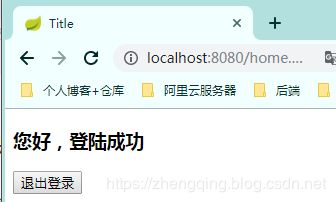Spring Security 自定义登录认证(二)
一、前言
本篇文章将讲述Spring Security自定义登录认证校验用户名、密码,自定义密码加密方式,以及在前后端分离的情况下认证失败或成功处理返回json格式数据
温馨小提示:Spring Security中有默认的密码加密方式以及登录用户认证校验,但小编这里选择自定义是为了方便以后业务扩展,比如系统默认带一个超级管理员,当认证时识别到是超级管理员账号登录访问时给它赋予最高权限,可以访问系统所有api接口,或在登录认证成功后存入token以便用户访问系统其它接口时通过token认证用户权限等
Spring Security入门学习可参考之前文章:
SpringBoot集成Spring Security入门体验(一)
https://blog.csdn.net/qq_38225558/article/details/101754743
二、Spring Security 自定义登录认证处理
基本环境
- spring-boot 2.1.8
- mybatis-plus 2.2.0
- mysql
- maven项目
案例中关于对该
t_sys_user用户表相关的增删改查代码就不贴出来了,如有需要可参考文末提供的案例demo源码
1、Security 核心配置类
配置用户密码校验过滤器
@Configuration
@EnableWebSecurity
@EnableGlobalMethodSecurity(prePostEnabled = true)
public class SecurityConfig extends WebSecurityConfigurerAdapter {
/**
* 用户密码校验过滤器
*/
private final AdminAuthenticationProcessingFilter adminAuthenticationProcessingFilter;
public SecurityConfig(AdminAuthenticationProcessingFilter adminAuthenticationProcessingFilter) {
this.adminAuthenticationProcessingFilter = adminAuthenticationProcessingFilter;
}
/**
* 权限配置
* @param http
* @throws Exception
*/
@Override
protected void configure(HttpSecurity http) throws Exception {
ExpressionUrlAuthorizationConfigurer<HttpSecurity>.ExpressionInterceptUrlRegistry registry = http.antMatcher("/**").authorizeRequests();
// 禁用CSRF 开启跨域
http.csrf().disable().cors();
// 登录处理 - 前后端一体的情况下
// registry.and().formLogin().loginPage("/login").defaultSuccessUrl("/").permitAll()
// // 自定义登陆用户名和密码属性名,默认为 username和password
// .usernameParameter("username").passwordParameter("password")
// // 异常处理
// .failureUrl("/login/error").permitAll()
// // 退出登录
// .and().logout().permitAll();
// 标识只能在 服务器本地ip[127.0.0.1或localhost] 访问`/home`接口,其他ip地址无法访问
registry.antMatchers("/home").hasIpAddress("127.0.0.1");
// 允许匿名的url - 可理解为放行接口 - 多个接口使用,分割
registry.antMatchers("/login", "/index").permitAll();
// OPTIONS(选项):查找适用于一个特定网址资源的通讯选择。 在不需执行具体的涉及数据传输的动作情况下, 允许客户端来确定与资源相关的选项以及 / 或者要求, 或是一个服务器的性能
registry.antMatchers(HttpMethod.OPTIONS, "/**").denyAll();
// 自动登录 - cookie储存方式
registry.and().rememberMe();
// 其余所有请求都需要认证
registry.anyRequest().authenticated();
// 防止iframe 造成跨域
registry.and().headers().frameOptions().disable();
// 自定义过滤器认证用户名密码
http.addFilterAt(adminAuthenticationProcessingFilter, UsernamePasswordAuthenticationFilter.class);
}
}
2、自定义用户密码校验过滤器
@Slf4j
@Component
public class AdminAuthenticationProcessingFilter extends AbstractAuthenticationProcessingFilter {
/**
* @param authenticationManager: 认证管理器
* @param adminAuthenticationSuccessHandler: 认证成功处理
* @param adminAuthenticationFailureHandler: 认证失败处理
*/
public AdminAuthenticationProcessingFilter(CusAuthenticationManager authenticationManager, AdminAuthenticationSuccessHandler adminAuthenticationSuccessHandler, AdminAuthenticationFailureHandler adminAuthenticationFailureHandler) {
super(new AntPathRequestMatcher("/login", "POST"));
this.setAuthenticationManager(authenticationManager);
this.setAuthenticationSuccessHandler(adminAuthenticationSuccessHandler);
this.setAuthenticationFailureHandler(adminAuthenticationFailureHandler);
}
@Override
public Authentication attemptAuthentication(HttpServletRequest request, HttpServletResponse response) throws AuthenticationException {
if (request.getContentType() == null || !request.getContentType().contains(Constants.REQUEST_HEADERS_CONTENT_TYPE)) {
throw new AuthenticationServiceException("请求头类型不支持: " + request.getContentType());
}
UsernamePasswordAuthenticationToken authRequest;
try {
MultiReadHttpServletRequest wrappedRequest = new MultiReadHttpServletRequest(request);
// 将前端传递的数据转换成jsonBean数据格式
User user = JSONObject.parseObject(wrappedRequest.getBodyJsonStrByJson(wrappedRequest), User.class);
authRequest = new UsernamePasswordAuthenticationToken(user.getUsername(), user.getPassword(), null);
authRequest.setDetails(authenticationDetailsSource.buildDetails(wrappedRequest));
} catch (Exception e) {
throw new AuthenticationServiceException(e.getMessage());
}
return this.getAuthenticationManager().authenticate(authRequest);
}
}
3、自定义认证管理器
@Component
public class CusAuthenticationManager implements AuthenticationManager {
private final AdminAuthenticationProvider adminAuthenticationProvider;
public CusAuthenticationManager(AdminAuthenticationProvider adminAuthenticationProvider) {
this.adminAuthenticationProvider = adminAuthenticationProvider;
}
@Override
public Authentication authenticate(Authentication authentication) throws AuthenticationException {
Authentication result = adminAuthenticationProvider.authenticate(authentication);
if (Objects.nonNull(result)) {
return result;
}
throw new ProviderNotFoundException("Authentication failed!");
}
}
4、自定义认证处理
这里的密码加密验证工具类PasswordUtils可在文末源码中查看
@Component
public class AdminAuthenticationProvider implements AuthenticationProvider {
@Autowired
UserDetailsServiceImpl userDetailsService;
@Autowired
private UserMapper userMapper;
@Override
public Authentication authenticate(Authentication authentication) throws AuthenticationException {
// 获取前端表单中输入后返回的用户名、密码
String userName = (String) authentication.getPrincipal();
String password = (String) authentication.getCredentials();
SecurityUser userInfo = (SecurityUser) userDetailsService.loadUserByUsername(userName);
boolean isValid = PasswordUtils.isValidPassword(password, userInfo.getPassword(), userInfo.getCurrentUserInfo().getSalt());
// 验证密码
if (!isValid) {
throw new BadCredentialsException("密码错误!");
}
// 前后端分离情况下 处理逻辑...
// 更新登录令牌 - 之后访问系统其它接口直接通过token认证用户权限...
String token = PasswordUtils.encodePassword(System.currentTimeMillis() + userInfo.getCurrentUserInfo().getSalt(), userInfo.getCurrentUserInfo().getSalt());
User user = userMapper.selectById(userInfo.getCurrentUserInfo().getId());
user.setToken(token);
userMapper.updateById(user);
userInfo.getCurrentUserInfo().setToken(token);
return new UsernamePasswordAuthenticationToken(userInfo, password, userInfo.getAuthorities());
}
@Override
public boolean supports(Class<?> aClass) {
return true;
}
}
其中小编自定义了一个UserDetailsServiceImpl类去实现UserDetailsService类 -> 用于认证用户详情
和自定义一个SecurityUser类实现UserDetails类 -> 安全认证用户详情信息
@Service("userDetailsService")
public class UserDetailsServiceImpl implements UserDetailsService {
@Autowired
private UserMapper userMapper;
/***
* 根据账号获取用户信息
* @param username:
* @return: org.springframework.security.core.userdetails.UserDetails
*/
@Override
public UserDetails loadUserByUsername(String username) throws UsernameNotFoundException {
// 从数据库中取出用户信息
List<User> userList = userMapper.selectList(new EntityWrapper<User>().eq("username", username));
User user;
// 判断用户是否存在
if (!CollectionUtils.isEmpty(userList)){
user = userList.get(0);
} else {
throw new UsernameNotFoundException("用户名不存在!");
}
// 返回UserDetails实现类
return new SecurityUser(user);
}
}
安全认证用户详情信息
@Data
@Slf4j
public class SecurityUser implements UserDetails {
/**
* 当前登录用户
*/
private transient User currentUserInfo;
public SecurityUser() {
}
public SecurityUser(User user) {
if (user != null) {
this.currentUserInfo = user;
}
}
@Override
public Collection<? extends GrantedAuthority> getAuthorities() {
Collection<GrantedAuthority> authorities = new ArrayList<>();
SimpleGrantedAuthority authority = new SimpleGrantedAuthority("admin");
authorities.add(authority);
return authorities;
}
@Override
public String getPassword() {
return currentUserInfo.getPassword();
}
@Override
public String getUsername() {
return currentUserInfo.getUsername();
}
@Override
public boolean isAccountNonExpired() {
return true;
}
@Override
public boolean isAccountNonLocked() {
return true;
}
@Override
public boolean isCredentialsNonExpired() {
return true;
}
@Override
public boolean isEnabled() {
return true;
}
}
5、自定义认证成功或失败处理方式
- 认证成功处理类实现
AuthenticationSuccessHandler类重写onAuthenticationSuccess方法 - 认证失败处理类实现
AuthenticationFailureHandler类重写onAuthenticationFailure方法
在前后端分离情况下小编认证成功和失败都返回json数据格式
认证成功后这里小编只返回了一个token给前端,其它信息可根据个人业务实际处理
@Component
public class AdminAuthenticationSuccessHandler implements AuthenticationSuccessHandler {
@Override
public void onAuthenticationSuccess(HttpServletRequest httpServletRequest, HttpServletResponse response, Authentication auth) throws IOException, ServletException {
User user = new User();
SecurityUser securityUser = ((SecurityUser) auth.getPrincipal());
user.setToken(securityUser.getCurrentUserInfo().getToken());
ResponseUtils.out(response, ApiResult.ok("登录成功!", user));
}
}
认证失败捕捉异常自定义错误信息返回给前端
@Slf4j
@Component
public class AdminAuthenticationFailureHandler implements AuthenticationFailureHandler {
@Override
public void onAuthenticationFailure(HttpServletRequest httpServletRequest, HttpServletResponse response, AuthenticationException e) throws IOException, ServletException {
ApiResult result;
if (e instanceof UsernameNotFoundException || e instanceof BadCredentialsException) {
result = ApiResult.fail(e.getMessage());
} else if (e instanceof LockedException) {
result = ApiResult.fail("账户被锁定,请联系管理员!");
} else if (e instanceof CredentialsExpiredException) {
result = ApiResult.fail("证书过期,请联系管理员!");
} else if (e instanceof AccountExpiredException) {
result = ApiResult.fail("账户过期,请联系管理员!");
} else if (e instanceof DisabledException) {
result = ApiResult.fail("账户被禁用,请联系管理员!");
} else {
log.error("登录失败:", e);
result = ApiResult.fail("登录失败!");
}
ResponseUtils.out(response, result);
}
}
温馨小提示:
前后端一体的情况下可通过在Spring Security核心配置类中配置异常处理接口然后通过如下方式获取异常信息
AuthenticationException e = (AuthenticationException) request.getSession().getAttribute("SPRING_SECURITY_LAST_EXCEPTION");
System.out.println(e.getMessage());
三、前端页面
这里2个简单的html页面模拟前后端分离情况下登陆处理场景
1、登陆页
login.html
<html lang="en">
<head>
<meta charset="UTF-8">
<title>Logintitle>
head>
<body>
<h1>Spring Securityh1>
<form method="post" action="" onsubmit="return false">
<div>
用户名:<input type="text" name="username" id="username">
div>
<div>
密码:<input type="password" name="password" id="password">
div>
<div>
<button onclick="login()">登陆button>
div>
form>
body>
<script src="http://libs.baidu.com/jquery/1.9.0/jquery.js" type="text/javascript">script>
<script type="text/javascript">
function login() {
var username = document.getElementById("username").value;
var password = document.getElementById("password").value;
// var rememberMe = document.getElementById("remember-me").value;
$.ajax({
async: false,
type: "POST",
dataType: "json",
url: '/login',
contentType: "application/json",
data: JSON.stringify({
"username": username,
"password": password
// "remember-me": rememberMe
}),
success: function (result) {
console.log(result)
if (result.code == 200) {
alert("登陆成功");
window.location.href = "../home.html";
} else {
alert(result.message)
}
}
});
}
script>
html>
2、首页
home.html
<html lang="en">
<head>
<meta charset="UTF-8">
<title>Titletitle>
head>
<body>
<h3>您好,登陆成功h3>
<button onclick="window.location.href='/logout'">退出登录button>
body>
html>
四、测试接口
@Slf4j
@RestController
public class IndexController {
@GetMapping("/")
public ModelAndView showHome() {
return new ModelAndView("home.html");
}
@GetMapping("/index")
public String index() {
return "Hello World ~";
}
@GetMapping("/login")
public ModelAndView login() {
return new ModelAndView("login.html");
}
@GetMapping("/home")
public String home() {
String name = SecurityContextHolder.getContext().getAuthentication().getName();
log.info("登陆人:" + name);
return "Hello~ " + name;
}
@GetMapping(value ="/admin")
// 访问路径`/admin` 具有`crud`权限
@PreAuthorize("hasPermission('/admin','crud')")
public String admin() {
return "Hello~ 管理员";
}
@GetMapping("/test")
// @PreAuthorize("hasPermission('/test','t')")
public String test() {
return "Hello~ 测试权限访问接口";
}
/**
* 登录异常处理 - 前后端一体的情况下
* @param request
* @param response
*/
@RequestMapping("/login/error")
public void loginError(HttpServletRequest request, HttpServletResponse response) {
AuthenticationException e = (AuthenticationException) request.getSession().getAttribute("SPRING_SECURITY_LAST_EXCEPTION");
log.error(e.getMessage());
ResponseUtils.out(response, ApiResult.fail(e.getMessage()));
}
}
五、测试访问效果
数据库账号:admin 密码:123456
1. 输入错误用户名提示该用户不存在
2. 输入错误密码提示密码错误
3. 输入正确用户名和账号,提示登陆成功,然后跳转到首页
登陆成功后即可正常访问其他接口,如果是未登录情况下将访问不了
温馨小提示:这里在未登录时或访问未授权的接口时,后端暂时没有做处理,相关案例将会放在后面的权限控制案例教程中讲解
六、总结
- 在
Spring Security核心配置类中设置自定义的用户密码校验过滤器(AdminAuthenticationProcessingFilter) - 在自定义的用户密码校验过滤器中配置
认证管理器(CusAuthenticationManager)、认证成功处理(AdminAuthenticationSuccessHandler)和认证失败处理(AdminAuthenticationFailureHandler)等 - 在自定义的认证管理器中配置自定义的
认证处理(AdminAuthenticationProvider) - 然后就是在认证处理中实现自己的相应业务逻辑等
Security相关代码结构:
本文案例源码
https://gitee.com/zhengqingya/java-workspace







